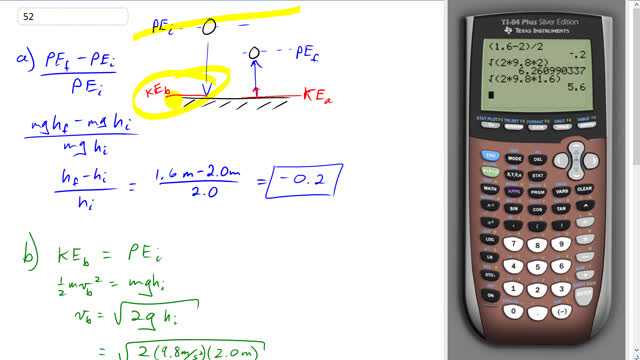
You drop a ball from a height of 2.0 m, and it bounces back to a height of 1.6 m.
- What fraction of its initial energy is lost during the bounce?
- What is the ball’s speed just before and just after the bounce?
- Where did the energy go?
- heat

In order to watch this solution you need to have a subscription.
This is Giancoli Answers with Mr. Dychko. This ball fell from some additional height where it had some additional gravitational potential energy; that it has some kinetic energy just before it hits the ground so that's what the subscript b stands for, before it hits the ground. And then after it's finished, you know, compressing and then rebounding, it had some kinetic energy after the bounce. That's gonna be a little less than the kinetic energy it has before the bounce because some of the energy is lost to heat due to friction, internally in the ball and with the ground. And then, it will rise up to some other height that's less than the initial height and will have some potential energy that's final, which is less than what it had initially. So let's figure out what fraction is lost first by going potential energy final minus initial all divided by initial. So that's mg height final minus mg height initial divided by mg height initial. And all the mg's cancel there; and we are left with 1.6 meters minus 2 all divided by 2, which is negative 0.2. So 20 percent of the energy was lost due to the friction and heat produced by the bounce. And, the kinetic energy that it has just before the bounce is equal to all the potential energy that it had initially and assuming no energy was lost due to friction of the air, and we have one-half m times velocity before the bounce equals mg times height initial and you can solve that for v b by multiplying both sides by 2 and dividing both sides by m so the m's cancel there and we are gonna take the square root of both sides and you have v before equals square root 2gh initial which is square root 2 times 9.8 meters per second squared times 2 meters which is 6.3 meters per second. And then right after the bounce, we can figure out what that kinetic energy must be and therefore, the speed that it has after the bounce by equating the kinetic energy after the bounce with the final potential energy that it has. And so multiply both sides by 2 over m, same algebra, and we get v after the bounce is square root 2 times 9.8 times 1.6 meters and which is 5.6 meters per second. And all that energy that was lost between, before and after the bounce, goes into heat.
Can you give a brief explanation of what you mean by "energy goes into heat"? Is it transformed into heat? Thanks.
Hi Icbishop, yes exactly. By "energy goes into heat" I mean to say "energy is transformed into heat energy". Rather than being gravitational potential energy, or kinetic energy, some of the energy is transformed into heat. This is the result of friction between particles in the ball when it gets squished upon colliding with the ground. The same could be said for particles in the ground internally "rubbing" and creating heat as the result of friction. Plus particles of the ground rub against particles of the ball. What I didn't mention is that some energy turns into sound energy, but this is typically very small compared to the amount turned into heat.
Hope that helps,
Mr. Dychko
Why can we assume in part b that there was no energy lost by friction? Part a and part b was asking about frictional force so I thought we had to take it into account.
so friction by air is not taken into account but we have to consider the thermal energy during the bounce?
This is late but for anyone that comes across this and wants a theory related answer: Feynman did a good job explaining this phenomenon-- if we consider conservation of energy in the universe then imagine, essentially, the movement of the atoms within the ball transferring that "lost" energy into the floors atom. So, the jiggling (heat, internal energy) of the ball transfers a portion to the floor, whose atoms are now jiggling a bit more than they were once before.
Hi hexxilated, thank you so much for this great contribution to the conversation. I would add that heat is transferred to several objects, the floor being only one of them. If I had to guess, my assumption would be that most of the heat is transferred to the ball itself. The friction between ball molecules generates heat within the ball - so the temperature of the ball would increase. Certainly some of that would transfer to the floor, but since the ball and floor are in contact for only a brief instant this would be only a small transfer of energy. The principal transformation is from kinetic energy of the ball to thermal energy of the ball. Anyone who's played squash is familiar with how much a ball warms up after impact - the ball actually feels warm and bounces differently after it's been "warmed up".
All the best,
Shaun